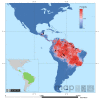Ecology of Anopheles darlingi Root with respect to vector importance: a review
- PMID: 21923902
- PMCID: PMC3183005
- DOI: 10.1186/1756-3305-4-177
Ecology of Anopheles darlingi Root with respect to vector importance: a review
Abstract
Anopheles darlingi is one of the most important malaria vectors in the Americas. In this era of new tools and strategies for malaria and vector control it is essential to have knowledge on the ecology and behavior of vectors in order to evaluate appropriateness and impact of control measures. This paper aims to provide information on the importance, ecology and behavior of An. darlingi. It reviews publications that addressed ecological and behavioral aspects that are important to understand the role and importance of An. darlingi in the transmission of malaria throughout its area of distribution. The results show that Anopheles darlingi is especially important for malaria transmission in the Amazon region. Although numerous studies exist, many aspects determining the vectorial capacity of An. darlingi, i.e. its relation to seasons and environmental conditions, its gonotrophic cycle and longevity, and its feeding behavior and biting preferences, are still unknown. The vector shows a high degree of variability in behavioral traits. This makes it difficult to predict the impact of ongoing changes in the environment on the mosquito populations. Recent studies indicate a good ability of An. darlingi to adapt to environments modified by human development. This allows the vector to establish populations in areas where it previously did not exist or had been controlled to date. The behavioral variability of the vector, its adaptability, and our limited knowledge of these impede the establishment of effective control strategies. Increasing our knowledge of An. darlingi is necessary.
Figures
Similar articles
-
Behavioral patterns, parity rate and natural infection analysis in anopheline species involved in the transmission of malaria in the northeastern Brazilian Amazon region.Acta Trop. 2016 Dec;164:216-225. doi: 10.1016/j.actatropica.2016.09.018. Epub 2016 Sep 19. Acta Trop. 2016. PMID: 27659096
-
Larval food quantity affects development time, survival and adult biological traits that influence the vectorial capacity of Anopheles darlingi under laboratory conditions.Malar J. 2012 Aug 2;11:261. doi: 10.1186/1475-2875-11-261. Malar J. 2012. PMID: 22856645 Free PMC article.
-
Integrated vector management targeting Anopheles darlingi populations decreases malaria incidence in an unstable transmission area, in the rural Brazilian Amazon.Malar J. 2012 Oct 23;11:351. doi: 10.1186/1475-2875-11-351. Malar J. 2012. PMID: 23088224 Free PMC article.
-
Ecology of malaria vectors in the Americas and future direction.Mem Inst Oswaldo Cruz. 1992;87 Suppl 3:371-83. doi: 10.1590/s0074-02761992000700064. Mem Inst Oswaldo Cruz. 1992. PMID: 1343717 Review.
-
Malaria vector species in Colombia: a review.Mem Inst Oswaldo Cruz. 2011 Aug;106 Suppl 1(Suppl 1):223-38. doi: 10.1590/s0074-02762011000900028. Mem Inst Oswaldo Cruz. 2011. PMID: 21881778 Free PMC article. Review.
Cited by
-
Malaria Risk Drivers in the Brazilian Amazon: Land Use-Land Cover Interactions and Biological Diversity.Int J Environ Res Public Health. 2023 Aug 1;20(15):6497. doi: 10.3390/ijerph20156497. Int J Environ Res Public Health. 2023. PMID: 37569037 Free PMC article.
-
Seasonal genetic partitioning in the neotropical malaria vector, Anopheles darlingi.Malar J. 2014 May 29;13:203. doi: 10.1186/1475-2875-13-203. Malar J. 2014. PMID: 24885508 Free PMC article.
-
Malaria vectors in ecologically heterogeneous localities of the Colombian Pacific region.PLoS One. 2014 Aug 4;9(8):e103769. doi: 10.1371/journal.pone.0103769. eCollection 2014. PLoS One. 2014. PMID: 25090233 Free PMC article.
-
Larval habitat characterization of Anopheles darlingi from its northernmost geographical distribution in Chiapas, Mexico.Malar J. 2015 Dec 22;14:517. doi: 10.1186/s12936-015-1037-0. Malar J. 2015. PMID: 26693816 Free PMC article.
-
Lords of the flies: dipteran migrants are diverse, abundant and ecologically important.Biol Rev Camb Philos Soc. 2025 Aug;100(4):1635-1659. doi: 10.1111/brv.70017. Epub 2025 Apr 1. Biol Rev Camb Philos Soc. 2025. PMID: 40165599 Free PMC article. Review.
References
-
- Forattini OP. Compartemento exofilo de Anopheles darlingi Root, em regiảo meridional do Brasil. Exophilic Behavior of Anopheles darlingi Root in a southern region of Brazil. Rev Saứde Publ. 1987;21:291–304. - PubMed
-
- Deane LM, Causey OR, Deane MP. Notas sôbre a distribuição e a biologia dos anofelinos das regiões nordestina e amazônica do Brasil. Rev Serv Espec Saude Publ. 1948;1:827–965.
-
- Rachou RG. Anofelinos do Brasil. Comportamento das species vetoras de malaria. Rev Braz Malariol Doenças Trop. 1958;10:145–181.
-
- Komp WHW. The occurrence of Anopheles darlingi Root in Central America. Am J Trop Med Hyg. 1941;21:659–670.
Publication types
MeSH terms
LinkOut - more resources
Full Text Sources
Medical


